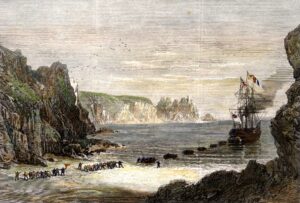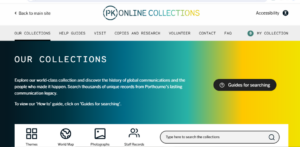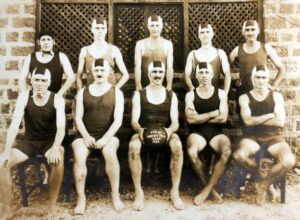In March 2023, PK Porthcurno was thrilled to receive funding from The National Archives ‘Archives Resilience Grant’ which aims to support archives to create sustainable solutions that enable them to respond to and manage change. PK Porthcurno owns and operates the Museum of Global Communications, telling the story of our connected world, from the arrival of Porthcurno’s first undersea telegraph cable in 1870 to the worldwide communications we all use today.

Figure 1: Landing the first telegraph cable at Porthcurno in 1870
The museum owns and manages the business archive of Cable and Wireless, which includes documents, photographs, films, artwork, maps, charts, and objects regarding the development of international communications dating from the 1850’s onwards. In 2009 the archive was awarded Designated Status from Arts Council England, recognising it as an outstanding, world class collection. The archive is used by academics, researchers, family historians, student placements, and museum staff, and has been the focus of five PhDs, with the latest PhD beginning in September 2023. As the archive holds material relating to global histories and communities, researchers have visited the archive from all over the world, including India, Australia, and the USA.

Figure 2: Map showing telegraph cable routes in 1870
As well as the physical archive, we also hold an increasing collection of digital archive material. This includes over 9000 photographs that have been scanned by our dedicated archive volunteers over the last ten years. We also have a collection of 400 engineer reports for telegraph cable laying and repair work dating from the 1870s onwards which were digitised with generous support from Subsea Environmental Services.
PK Porthcurno’s mission statement is to use the collections, site, and digital presence to reflect and explore the subject of global communications and the international communities that have grown around them. Towards this aim, the PK Online Collections was launched in 2022 providing online access to the entire collection, including digitised photographs where available. As users can now explore the archive for themselves online, the capacity of our small collection team has been significantly increased.

Figure 3: PK Online Collections
The positive impact of providing access to digitised material has highlighted the need to ensure the preservation and continued development of the digital archive. With this in mind, we undertook a Digital Storage Report to review existing storage and future needs. The report clearly demonstrated that there was not sufficient storage capacity for expected collecting activity, especially with plans to develop both a new oral history project and to continue to scan archive material to increase accessibility.
Working with our external IT support company, the Archive Resilience Grant enabled us to improve the preservation and security of the digital archive through the purchase and installation of a Synology NAS drive, which is backed up daily to our cloud-based storage.
Based on our Digital Storage Report, we were able to identify how much digital storage we would require for at least the next ten years, ensuring that we can continue to collect and store digital material. Collecting ‘born digital’ material is especially important for us to ensure that the history of global communications remains relevant.
With the Synology NAS drive, we can now ensure that our digital archive is secure, with access to the material being given to collection staff and our IT support only, significantly reducing the risk of files being modified or deleted. This project also allowed us to focus on re-organising the material to make file access and retrieval quick and simple.
Before this project, the creation and acceptance of digitised archive material had been an organic process that was unsustainable. We now have a Digital Preservation Policy and Plan to ensure consistency in how these files are managed, ensuring that all current and future digitised archive material is properly cared for, as well as futureproofing our digital archive. The collection team is now able to process digitised material more quickly and accurately.
We also created a separate folder of usable digital material on an existing museum NAS drive. This can be accessed by all museum staff, enabling them to explore and utilise these resources effectively for engagement activities and publicity, minimising the input needed from the collection team.

Figure 4: Aden water polo team 1926
The Archive Resilience Grant has enabled us to continue to develop our digital archive and increase access to this outstanding, world-class collection, both internally and externally. By having the digital infrastructure in place to preserve and care for our digital archive, we have significantly reduced the risk of losing this key part of the collection.
This project has had a significant impact on the capacity of the collection team to continue to develop and care for the collection, increasing the richness of the archive for both the organisation and our users. The PK Online Collections has already enabled a range of users to explore the collection, decolonising the material and leading to new and exciting research. By increasing the amount of digitised material available online, we will be able to continue to engage with a diverse audience, ensuring that the archive remains an inclusive collection.
Charlotte Todd, Head of Collections & Engagement, at PK Porthcurno